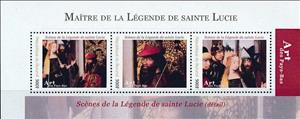Mini Sheet: Paintings - Master of the Legend of Saint Lucy (Burundi 2012)
Paintings - Master of the Legend of Saint Lucy (Burundi 2012)
01 January (Burundi ) within release Paintings (2012) goes into circulation Mini Sheet Paintings - Master of the Legend of Saint Lucy face value 3*500 Burundian franc
| Mini Sheet Paintings - Master of the Legend of Saint Lucy in catalogues | |
|---|---|
| Colnect codes: | Col: BI 2012-52 |
Mini Sheet is square format.
No year date inscribed on the counterfeit stamps. Illegal stamps produced in Eastern Europe and distributed by Eastern European counterfeit stamp dealers. Dating on many based on year they first appeared which in this case is 2012. BEWARE of criminal sellers offering them as "issued" in different years other than this. Avoid anyone selling these!Also in the issue Paintings (2012):
- Mini Sheet - Paintings - Master of the Legend of Saint Lucy face value 3*500;
- Mini Sheet - Paintings - Master of the Legend of Saint Lucy face value 3*500;
Mini Sheet Paintings - Master of the Legend of Saint Lucy it reflects the thematic directions:
Painting is the practice of applying paint, pigment, color or other medium to a solid surface (support base). The medium is commonly applied to the base with a brush, but other implements, such as knives, sponges, and airbrushes, can be used. Painting is a mode of creative expression, and the forms are numerous. Drawing, gesture (as in gestural painting), composition, narration (as in narrative art), or abstraction (as in abstract art), among other aesthetic modes, may serve to manifest the expressive and conceptual intention of the practitioner. Paintings can be naturalistic and representational (as in a still life or landscape painting), photographic, abstract, narrative, symbolistic (as in Symbolist art), emotive (as in Expressionism), or political in nature (as in Artivism). A portion of the history of painting in both Eastern and Western art is dominated by spiritual motifs and ideas. Examples of this kind of painting range from artwork depicting mythological figures on pottery, to Biblical scenes rendered on the interior walls and ceiling of the Sistine Chapel, to scenes from the life of Buddha or other images of Eastern religious origin. In art, the term painting describes both the act and the result of the action. The support for paintings includes such surfaces as walls, paper, canvas, wood, glass, lacquer, clay, leaf, copper and concrete, and the painting may incorporate multiple other materials including sand, clay, paper, plaster, gold leaf, as well as objects. The term painting is also used outside of art as a common trade among craftsmen and builders.
n Christian belief, a saint is a person who is recognized as having an exceptional degree of holiness, likeness, or closeness to God. However, the use of the term saint depends on the context and denomination. In Catholic, Eastern Orthodox, Anglican, Oriental Orthodox, and Lutheran doctrine, all of their faithful deceased in Heaven are considered to be saints, but a selected few are considered worthy of greater honor or emulation. Official ecclesiastical recognition, and veneration, is conferred on some denominational saints through the process of canonization in the Catholic Church or glorification in the Eastern Orthodox Church after their approval.In many Protestant denominations saint refers broadly to any holy Christian, without special recognition or selection.


